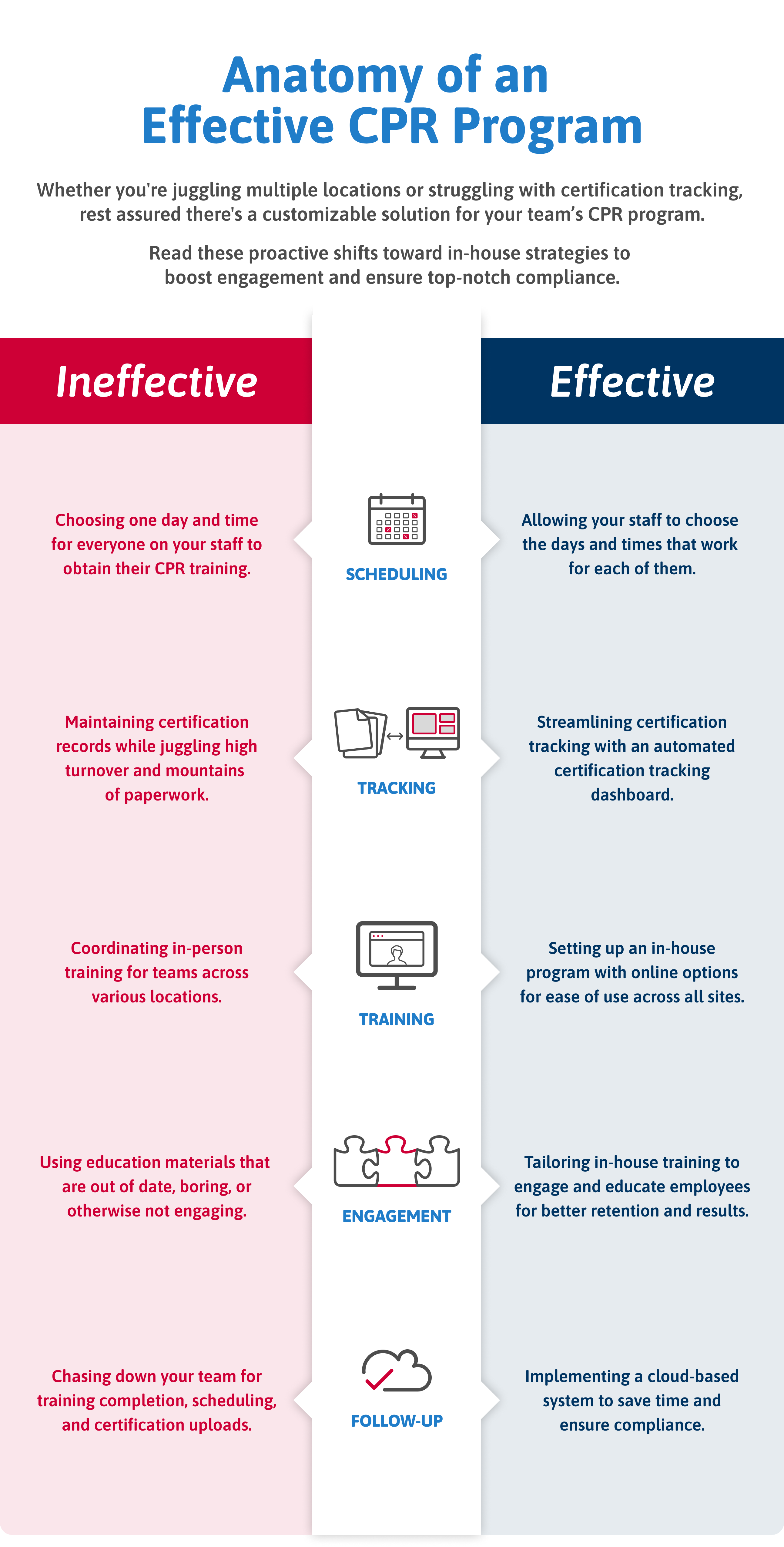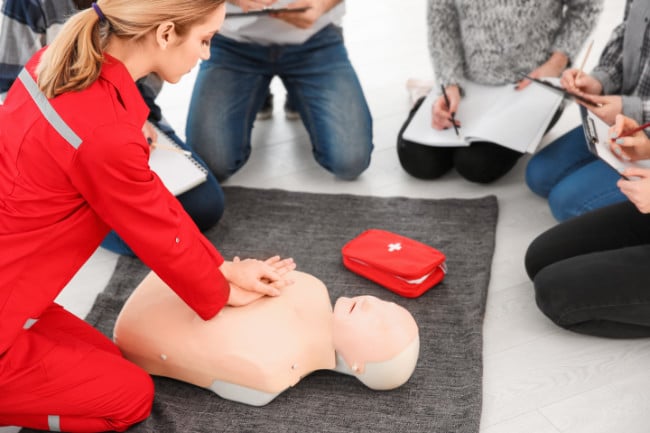Table of Contents
- Hallmarks of an Effective In-House CPR Program
- Common CPR Training Challenges
- Simplify & Strengthen Your CPR Program
- Empower Your Workforce
In-house CPR training may seem like the most convenient option for ensuring your employees meet CPR compliance requirements, but it has its share of challenges. When you do all your training in-house, not only do you need to bring in yet another employee, but you also end up dealing with added logistical hassles of paperwork and scheduling.
Many corporate CPR programs fail to provide adequate training because of scheduling conflicts, insufficient instruction methods, disorganized record-keeping, or all of the above. With the right blend of online and in-person training, you can eliminate these headaches and increase efficiency without having to add new staff members to the equation.
Overhauling the CPR training program may not be feasible for every workplace — at least, not immediately. But with the right adjustments, you can still bring many of the benefits of blended training to your in-house CPR training program.
Read on to learn how a CPR online certification program with blended online and in-person training can help you simplify and strengthen your in-house CPR training program for maximum effectiveness.
Hallmarks of an Effective In-House CPR Program
Getting your employees trained and certified to administer CPR is about more than just letting them earn a certification card — it’s about helping them apply their skills and knowledge to save lives in a crisis.
An effective CPR training program is easily accessible to all employees.
A recent study found that hands-on training significantly increased participants’ self-confidence in administering CPR in general. Along with that confidence, participants also indicated increased willingness to perform CPR on a stranger.
Furthermore, effective training goes beyond a one-time certification. Skills of any kind must be practiced and regularly refreshed so they aren’t forgotten. A solid in-house CPR training program, then, should include regular updates and reminders to help employees retain the skills they’ve learned.
Common CPR Training Shortcomings
Like any new system or process, implementing a new CPR training program, whether it’s online or in-house, comes with challenges.
Acknowledging the impact of various factors like how your organization operates and the level of engagement from your employees is the first step to simplifying your CPR training program. By understanding these dynamics, you build a sustainable training program that resonates with the diverse individuals within your organization.
The most common CPR training challenges include (but are not limited to):
- Employee Turnover: High turnover imposes a risk of improper tracking of new hires and exiting employees. This can result in CPR certifications being out-of-date or missing entirely.
- Dispersed Team Members: While dispersed teams work more efficiently and reach goals quicker than exclusively in-house teams, they also take longer to fail when people and mistakes slip through the cracks, costing companies money and resources over time.
- Staff Availability: Scheduling group CPR training for organizations requiring constant staffing can be tricky, potentially leading to overtime costs if staff attend on their day off.
- Staff Compliance: Ensuring staff compliance with CPR training can be challenging, as simply transitioning training in-house doesn’t guarantee engagement. Poor engagement creates gaps in preparedness and potential risks in emergency situations.
Read more about the Common CPR Training Challenges and how to overcome them in Everything You Need to Know About Building Your In-House CPR Training Program.
Every organization runs into these common CPR training challenges, so rest assured if you hit a roadblock. With the right training partner and structure in place, you can make CPR training easy and enjoyable for all.
Simplify & Strengthen Your CPR Training Program
If you already have an in-house CPR training program but it isn’t as effective or organized as it needs to be, there are a few measures you can take to improve the program and better equip your employees to handle emergencies.
Choosing the Right Training Provider
When it comes to selecting a CPR training provider, it’s essential to find one that aligns with your organization’s needs and values. Consider these factors when making your decision:
- Expertise and Certification: Look for training providers with a strong track record in CPR instruction and certification. The instructors must be certified and experienced in delivering high-quality training tailored to your industry’s specific requirements.
- Flexibility in Training Delivery: Assess whether the provider offers flexible training options that suit your organization’s schedule and preferences. Whether it’s fully in-person, online, or a blended approach, choose a provider that can adapt to your needs seamlessly. We’ve broken down the options for you below:
- Fully in-person: While a traditional classroom setting may not be ideal, you can enhance your in-person training by expanding your base of certified instructors who are already familiar with your organization and employees’ specific needs. This is a great way to ensure your employees have close access to qualified instruction.
- Fully online: A CPR online certification program allows employees to learn on their own time and in whatever environment is most conducive to their learning. This not only prevents scheduling snags but also helps ensure each employee gets the most out of their training.
- Blended online and in-person: A blended program allows you to tailor your CPR training to your organization’s bandwidth and resources. Supplement in-house training with virtual skills assessments or in-person assessments with online training and educational resources — whatever combination makes the most sense.
- Technology Integration: Explore training providers that leverage technology to streamline the learning experience. Platforms like ProTrainings can offer online courses and integrate with your existing learning management system, making training easily accessible and manageable for your employees.
- Customization and Tailoring: Seek providers that can customize training content to address the unique challenges and scenarios relevant to your workplace. A tailored approach allows your employees to receive training that is directly applicable to their roles and environment.
- Feedback and Reviews: Research feedback and reviews from other organizations that have used the training provider’s services. Positive testimonials and recommendations can give you confidence in your choice.
Setting Up for Success
The best way to have a successful CPR training program is to nurture a conducive learning environment and support structure for your employees. Take these steps to stay proactive:
- Communicate the importance of CPR training to all employees. Emphasize its role in emergency preparedness and workplace safety. Clear communication sets the stage for engagement and participation.
- Allocate adequate resources. Include time and budget to facilitate comprehensive CPR training for your workforce. Investing in training demonstrates a commitment to employee well-being and fosters a culture of preparedness.
- Provide access to appropriate training facilities and equipment. Whether for in-person sessions or virtual simulations, training environments that are conducive to learning and equipped with resources are necessary for all industries. A dedicated place to practice and refresh skills benefits everybody.
Stay prepared with our Adult CPR Practice video.
- Offer ongoing support to employees throughout their CPR training. Address any questions or concerns they may have. Implement follow-up mechanisms to reinforce learning and encourage regular skill refreshers.
Future-Proofing Your Program
To future-proof your CPR training program, adopt strategies that promote continuous improvement and adaptation to evolving needs:
- Stay updated with best practices. Regularly review and update your training curriculum to incorporate new guidelines and techniques. This also includes compliance. Regularly audit your program for adherence to legal requirements and industry guidelines.
- Take advantage of available technology. Explore options for virtual reality simulations, interactive modules, and mobile learning platforms to engage learners and reinforce skills.
The ProTrainings YouTube channel is a great place to start. We have various training videos to offer organizations an online option for curriculum development, such as our Recovery Position: A Step-by-Step Guide.
- Scalability and accessibility are key. Design your training program with scalability and accessibility in mind, accommodating the needs of a growing workforce and diverse learner demographics. Additionally, it’s beneficial for training materials to be accessible across different devices and platforms.
- Leverage feedback. Solicit input from employees, trainers, and stakeholders to identify areas for continuous improvement and refinement.
By prioritizing these strategies, you can future-proof your CPR training program and equip your employees with the skills and confidence to respond effectively to emergencies, safeguarding both their well-being and the success of your organization.

Empower Your Workforce
The most effective CPR training programs are designed with the understanding that life-saving skills should be accompanied by the confidence to apply them. If your CPR program is disorganized, not readily accessible to all employees, or focuses more on one-time certification than on effective teaching, it will continue to fall short of its goal.
Best Practices You Need to Know
To optimize your in-house CPR training program and guarantee its longevity, adhere to these streamlined best practices:
- Offer diverse training formats.
- Avoid dependency on a single instructor by certifying multiple team members.
- Store certification records securely in a cloud-based system for easy access, automatic updates, and streamlined sharing.
- Minimize learning curves with a training platform that seamlessly integrates with existing systems.
- Implement automated certification renewal reminders.
- Opt for provider flexibility with no class minimums or rigid financial commitments.
With flexible, accessible, empowering training and organized record-keeping, your CPR training program can truly save lives.
Contact us today to learn how ProTrainings’ CPR online certification program and blended training options can help make getting your staff CPR certified easier and more efficient.


